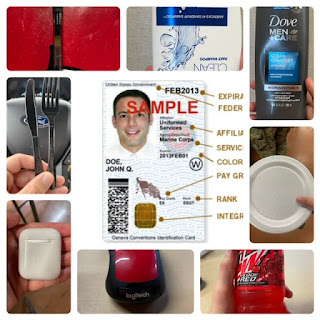Microplastics are plastics that are five millimeters in size or smaller. They are no bigger than a single grain of rice. There are two types of microplastics. The first one is considered a primary plastic because they were engineered to be small and are used for medical, industrial, and personal purposes. Secondary microplastics are the breakdown of plastics that come from larger plastics like bags bottles, netting, and rope. (Barrow, 2019) They can be hard to detect, and you would need a microscope to see most of them. They can be found in our oceans, rivers, lakes, and streams. Once they make into our waterways they can be found in the guts of fish, and other aquatic life.
Microplastics can get in our
waterways from several different ways. This includes trash entering our seas from boats
at sea, trash that gets into the ocean from beaches, and trash from rivers that feed into the ocean. Microplastics can also be found in most cosmetics which will
travel down drains from sinks and enter through our sewage systems which will
eventually be treated and reentered into our waterways. The problem is that
most of our filters cannot filter out most of the microplastics. Once the
plastics enter the ocean the currents then pull plastic into one of the great
garbage patches. The sun will then break them down into smaller
and smaller plastics which they will eventually shrink in size to become
microplastics. We have six great garbage patches with five of them being in the
sub-tropics and one being in the Artic in the Bering Sea. In the great garbage patch
in Pacific there is more weight in plastic then aquatic life. (Sebille, 2013)
Microplastics can be harmful to
aquatic life because they can block digestive tracts, diminish the urge to eat,
altering feeding behavior, reduce growth, and disrupt reproduction. (Rotye)
Microplastic can also absorb chemicals from runoff that enters our waterways. Plankton
can then grow on the plastic in which fish will eat. Birds will then eat the fish
passing on the microplastics and any chemicals through the
food change. Some of these chemicals are polychlorinated biph
(PCBs), polycycle aromatic hydrocarbons (PAHs), and heavy metals. Another
potential harm that can come from microplastics are microbeads that are found
in cosmetics. Phthalates are a group of chemicals that can be found in hundreds
of cosmetics like nail polish and hairspray. (Plastic Soup Foundation) This is
a chemical that could cause cancer because they react as an endocrine
disruptor. So far 15 countries have banned or will ban microbeads which includes
the United States, and Canada.
There are several things we can
do to slow down creation of microplastics from increasing and from entering our
waterways. First, we can refuse using plastics like water bottles, bags, and any other plastic that can’t not be reused. Instead, we should go after more environmentally
friendly items like biodegradable bags that can be found at most of our grocery stores
or refillable water bottles like Yeti or RTIC that can be reused numerous amounts
of times. This will help reduce the amount of plastic being used. Lastly, we
can recycle plastics which will help plastics to be reused. We can also pressure more countries
into banning microbeads that are found in cosmetics. I believe we all must be
actively engaged to reduce the amount of microplastics.
Cited Work:
Simons Foundation Science Sandbox (Producer). (2019). World class explorers
help scientists collect elusive data [Video]. Retrieved from
Van Sebille, E. (2013). Charting the
garbage patches of the seas [video]. University of New South Wales.
Retrieved from
International Campaign
Against Plastic in Cosmetics. Beat the Microbead. (2021, May 18). Retrieved
November 4, 2021, from https://www.beatthemicrobead.org/.
Dudas, S. (2018). Microplastics are everywhere [Video]. TEDx Binghampton University.Microplastics are everywhere | Sarah Dudas | TEDxBinghamtonUniversity

No comments:
Post a Comment